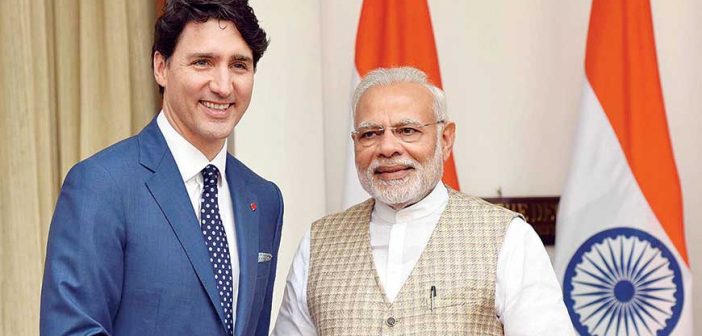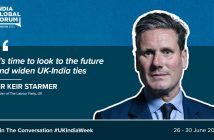Prime Minister Modi and Canadian Premier, Justin Trudeau, to steer past roadblocks towards greater economic cooperation.
The much anticipated Narendra Modi bear hug and welcome tweet took their time coming. These by now, signature Modi welcome rituals for visiting foreign leaders were delayed, experts and the media in both countries and, indeed, most of the free world speculated, to indicate India’s displeasure at Canadian Prime Minister Justin Trudeau and his Liberal Party’s alleged soft corner for Khalistani separatism.
India, long known for hectoring the world on moral and ideological issues, had learnt, under the Modi “doctrine”, to make a hard point with stony silence and a beaming smile. Little wonder then that the joint statement issued after the two-hour-long Modi-Trudeau meeting on 23 February, which by all accounts was held in a cordial atmosphere, focused in large measure on combating terrorism.
The underperforming economic relationship also received a boost. Bilateral merchandise trade between two of the world’s largest economies — India is the world’s sixth largest and Canada the tenth largest — with a combined GDP of about $4 trillion is a paltry $8.3 billion, according to figures from Statistics Canada. That’s a minuscule 0.2 per cent of all goods and services produced in these two countries. Compare that with Canada’s trade volume of almost $2 billion a day with the US and India’s $74-billion annual trade with the US and the difference will stand out starkly.
Both sides have made sporadic attempts in the past to push bilateral trade and investment into a higher growth trajectory but a mismatch of expectations and the domestic political compulsions of the current Canadian government have proved to be roadblocks.
It is not yet clear whether the issues delaying the signing of two major agreements between the two countries were resolved on this trip. The Canada-India Foreign Investment Protection Agreement (FIPA) and the Canada-India Comprehensive Economic Partnership Agreement (CEPA), that if signed, could add billions of dollars to each country’s GDP, have remained stalled for years now.
One major sticking point is the insistence of the Canadian side on “progressive trade” — with strong emphasis on enforcing Canadian standards on environment, gender, human rights, labour rights and other such issues that India considers extraneous to the economic dialogue. Despite this, both Modi and Trudeau signaled their determination to move forward and agreed to double efforts on bilateral investment, promotional agreement and comprehensive economic partnership.
Memoranda of Understandings and agreements worth about $1 billion were signed at Trudeau’s meeting with the crème-de-la-crème of Indian industry, which was attended by N. Chandrasekharan, Chairman of the Tata Group, Kumar Birla, Head of the A.V. Birla Group, and Anand Mahindra, Chief of the Mahindra Group, among others.
Under this, Indian companies will invest $250 million in Canada while Canadian companies will invest $750 million in India. But given the size of the two economies and the credentials of those present, this may well be seen as measly pickings. And in sharp contrast to the acrimony in the Canadian media, which had dubbed the visit a “disaster” even before the two leaders met, Trudeau called India a “natural partner and a trusted friend for commercial cooperation”.
In keeping with Modi’s focus on people-to-people contacts in the conduct of India’s foreign policy, which he has evocatively called a Living Bridge in the context of ties with the UK, the two countries extended their agreement to make it easier for Indian students to pursue higher education in Canada. More than 1,20,000 Indian students are currently studying in that country.
Another Modi priority, India’s energy security, was also in focus. The Modi government is committed to reduce India’s carbon footprint while meeting its energy needs by setting up 175 MW of renewable energy capacity by 2022. But as the Indian economy doubles in size from $2.5 trillion to $5 trillion in the foreseeable future, a lot more will have to be done. And Canada, an energy superpower, is expected to play a greater role in this area.
The two countries have also agreed to strengthen cooperation in healthcare, IT, startups, science and technology, defence and security, tourism and people-to-people contacts.
The big grizzly bear in the room, when Modi met Trudeau, was the perception that the Canadian government has a soft corner for separatist Sikh elements in Canada. Trudeau’s continuing molly-coddling of known sympathisers of the so-called Khalistani cause has been coming in the way of closer ties. Worse, Indian governments in the past have accused the Canadian government of actually providing shelter to those who are actively advocating separatism and providing funds and arms to their local agents in India.
Perhaps realising that the Indian government means business, Trudeau did try to make amends by declaring in no uncertain terms that his government is committed to the unity and integrity of One India. But I doubt if this will lead to any significant shift in his policies towards his hardline fringe constituency back home.
While it is true that the Sikh community are a solid and loyal vote bank for Trudeau’s party, only a small but very vocal, well-organised and well-funded minority among them support the separatists. The vast majority of Indian expatriates in Canada support closer ties with their country of origin, as was seen from the enthusiasm of the Indian diaspora during Modi’s visit to that country in 2015.
The highlight of the visit, in my opinion, was the coming of age of Indian foreign policy. Having made a political point, India decided to shift focus to economic cooperation — which has been the fulcrum of Modi’s entire foreign policy thrust.
So how should we judge this tour? Given the recent drift in bilateral ties, it is a good sign that the two sides have decided to stay engaged. Not doing so would have meant wasting an opportunity to create linkages with yet another G-7 member, with which India does not have any unresolved strategic issues.
The author is a London-based strategist and entrepreneur. He is the chief executive and managing editor of India Global Business magazine, and editor of a recent landmark study on India-UK Relations beyond Brexit.
This article was first published in BusinessWorld (BW) 5th March 2018.







